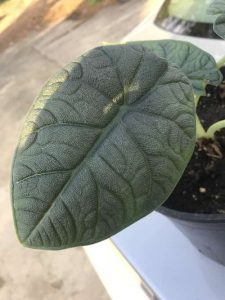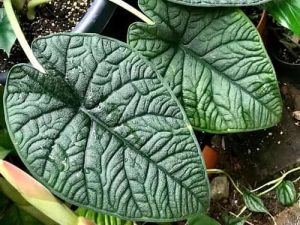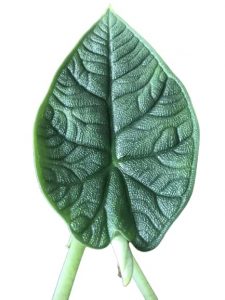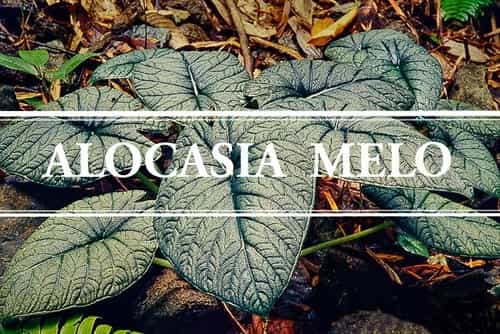Do you know which Jewel Alocasia has the thickest and most heavily textured leaves? The Alocasia Melo is another eye-catching Jewel, native to Sabah, Borneo. This plant is commonly known as the Alocasia rugosa, especially among commercial sellers. Moreover, it was first described successfully by the botanical name A.melo in 1997.
The jade green to greenish-blue leaves of this plant grows on erect terrestrial petioles. These leaves are thick enough to look like cardboard and confuse you with an artificial plant. These terrestrial growers can beautify any corner in your house to add the necessary oomph to the decor. Let us get to know about the thick-leaf, Jewel Melo Alocasia along with its care and propagation.
Alocasia Melo Classification
Family: Araceae.
Genus: Alocasia.
Species: Alocasia melo.
Genus Alocasia
The genus contains more than 79 perennial flowering species. The rainforests of Asia and Australia are the native place of these plants. The characteristic broad shape of the leaves associates the following common names with all the members of this genus.
- The African Mask plants.
- The Elephant-ear plants.
Other common and prominent feature of the members of this genus includes underground rhizomes. Alocasia are hybridized and cultivated on a large scale to produce a number of unique plants.
Features of the Alocasia Melo Plant

Height and Structure
- The plant remains under 1 to 2 feet in height.
- It is a terrestrial plant. Moreover, it likes to spread by forming short shrub-like structure.
Leaves
- A mature leaf is 30 to 50 cm long and around 25 cm wide.
- The thick rubbery leaves grow on erect petioles. The leaf is joined with the lamina at a downward angle.
Flowers
- Typical Anthurium-like flowers grows on the plant. The quantity of flowers is usually lesser than 3 at a time.
- These flowers are non-fragrant in nature and off-white in color.
Toxicity
All the jewel alocasias are highly toxic in nature. Ingestion may lead to severe allergic reactions to the skin and eyes. Thus, keep your kids and pets away from the plant.
Dormancy
We keep on repeating about the dormancy of Alocasias. Guys don’t get worried when the plant ceases to grow or sheds its leaves in winter. The plant is just ‘sleeping’ and will get up once the days get warm.
Alocasia Melo Care

Water Requirement
These plants like to dwell around the stones. Thus, they don’t like much water to reach their roots. Water the plant moderately after the upper 2 inches of the soil gets dry. We always share an estimated schedule to help you out with watering. In spring and summer, two to three days will be enough. However, the water requirement of the majority of plants decreased on the cooler days. Thus, once or twice will be enough according to the condition of the soil and the weather.
Just like the majority of Alocasias, these plants don’t tolerate wet feet. Thus, avoid overwatering and never let the oil get soggy.
Protection From Rain and Water-logging
An important part of the Care of the Alocasia rogusa plant is its intolerance towards rains. The plants can’t tolerate being waterlogged even for a few hours. Just the key is to keep the plant away from thunderstorms and rains. Thus, always keep them undercover and shade.
There are many customers who just forgot the plant outdoors. A single rain just got the plant ‘drowned’. Even quick rescues and drying out the plant and soil didn’t help. So, be aware guys!
Sunlight Requirement
The thick jade green leaves opt towards partial shade to bright indirect sunlight. If you want to keep them in artificial light, they are good to go. Make sure you keep the plant at a minimum distance of 40 cm from the bulb. Importantly, people usually misinterpret the thickness of foliage with its ability to withstand direct sunlight. However, these leaves are so tough, yet so delicate! The fierce sun can scorch out the leaves. Thus, avoid keeping the plant in direct sun.
Temperature Requirement
The optimum temperature for the plant is between 20 to 30 °C. Any temperature below 15 °C will disturb this cold-sensitive plant. So, we always advise shifting them to some warm area, as soon as the fall arrives. Similarly, the foliage will not look healthy as soon the temperature crosses 35 °C.
Soil Requirement
The Jewel Roguse rugose plants need well-drained soil with plenty of aeration. Consider some mixtures with Peat moss and sandy loams.
Humidity Requirement
Generally speaking, your Melos are humidity lovers. An ideal humidity level at day is about 75% while it is about 95 to 100% at night. You need to keep an eye on the humidity of the surroundings. In dry weather, consider adding a humidifier in the surroundings. Moreover, you can try mild misting, pebble-water tray under the pot, or plant grouping.
Fertilizer Requirement
Give a monthly dose of common NPK fertilizer or some domestic houseplant mix in the growing season. You can simply dilute the fertilizer or use 1/3rd to half of the stated dose. Nevertheless, the tough leafed Melo Alocasias will not require any added nutrition in fall and winter.
Pot Requirement
It’s simple guys! Use any smaller pot with drainage holes at the base.
Repotting Requirement
The roots like to be root bound. Thus, don’t change the pot unless you see the rhizome getting prominently big for the pot. Roots coming out of the drainage holes are another sign that the plant baby needs a new pot!
Pruning Requirement
The tough green leaves of the A. rugosa may need an annual or some frequent pruning. Simply cut the old or the unhealthy leaves, especially from the lower sides. This will help you maintain the health and appearance of the plant.
Alocasia Melo Propagation

The best and most common method to propagate an Alocasia is by the division of the rhizome.
Season
The best season to propagate these Jewel Plants is when the plant is growing actively. This is the spring and summer season.
Method
- The best practice is to propagate the plant while you are repotting.
- Just loose the soil around the parent plant and take it out gently.
- Take a knife and cut about 1/3rd of the rhizome.
- Replant both the rhizomes in your desired places. The growing medium should be slightly moist.
- Now, just place the baby plant in some warm humid place. The light should be indirect with medium to low intensity.
Growth Timeline
Let us have an estimate about the growth timings and required care for the plant. This is pretty helpful especially if you are a new peep in alocasia propagations.
Day 1 to Day 30: Mist the soil moderately once the upper layer just gets dry. Just keep the baby rhizome in a warm, humid place. Shoot development usually starts after the third week. Make sure you water smartly. As inadequate and under-watering may lead to a total loss of your efforts. (The rotting of rhizome)
Day 30 to Day 60: The ending of the 4th week usually brings the joy of the shoot development. Keep spraying the soil as described for the initial stage. And, you will soon be happy with the development of the baby plant.
Day 60 Onwards: A few thick green leaves uncurl gracefully by the end of the 2nd month. At this stage, you can finally stop pampering the plant baby. Just follow the Alocasia Melo Care shared in the previous section. Be ready to enjoy the growth of this super textured foliage.
Alocasia Melo Problems
The Common pests that can attack the plant include Aphids, Mealybugs, Scales, and Spider mites.
In initial attacks, you can simply squish the tiny attackers. After that, you can simply wash away the dead mess with a water spray. Make sure you avoid getting the water in the soil or come in contact with other plants. This will control the spread.
In case of a severe attack, get some commercially prepared insecticide spray. You can also use the neem oil to clean the foliage. However, consult a professional as a best practice.
Related Posts:
Summary
The Alocasia Melo is a jewel orchid with the thickest and most prominently textured leaves. The fresh green baby leaves mature to get a slate blue to jade green shade with darker veins. This plant is commonly known as Alocasia rugosa.
The Melo Plant Care includes indirect light, high humidity, and watering after the soil gets dry. These plants can not tolerate even a few hours under the rain. Thus, always keep them under the shade. Moreover, they carry the Alocasian legacy of toxicity. Keep the plant out of the reach of kids and pets.

